Maker projects can be tough if you don't have a good workspace. For a long time, mine was an ESD mat on the dining room table. But as my projects (and family) grew, I was under increased pressure to find somewhere else to work. Really, the 3D printer is what put my wife over the edge (and rightfully so).
Finding a decent place to work on electronics was more of a challenge than I expected. Lots of folks who left the dining room table seemed to work on card tables, repurposed IKEA tables and benches, and very expensive commercial electronics benches that are out of the price range of most part-time makers. I knew there had to be something in between.
As I was reading my copy of Practical Electronics For Inventors: 4th Edition by Paul Scherz and Simon Monk, there was a mention of a DIY Maker workbench that caught my eye. There's a brief description and a couple of diagrams, but no photos of it in use. I wanted to rectify that problem and document how I built mine, as I had to make some modifications and additions that I thought others might be interested in.
Since the book was written, the 18"-deep metal frame that was the basis of the bench is no longer available at Home Depot. The company that made it seems to have been swallowed up by another company, but they still make and stock a 24" deep version. I've compiled a hardware list that includes all the materials I used, along with links for anything that was not a simple commodity item. With the instructions from the book and my additions below, I'm sure you can build yourself a great maker workbench.
Bench highlights and modifications
- Full-spectrum LED work utility light (Uses very little power and is dimmable. Leaves more power available on this circuit for my electronics.)
- Custom-built worktop with Formica surface and hard maple edging
- Black shelf hardware and brackets
- Cherry-colored shelving
- Integrated USB outlet
- Corrected paint
Parts and hardware
- 1 72"x72"x24" Three-wire shelf heavy duty steel storage rack in black: $145
- 1 4'x8' 3/4"-thick MDF sheet: $30
- 1 4'x8' Sheet white Formica laminate: $40
- 2 3/4" CDX Plywood: $27/sheet
- 4/4" rough or 3/4" S4S hard maple (for bench top edging)
- 1 32oz DAP Weldwood contact cement
- 7 Metal one-gang outlets with brackets: $2.75 each
- 1 20 Amp GFCI Outlet, Decora style (i.e.,rectangle shape) with tamper-resistant holes: $20
- 4 20 Amp Decora outlets with tamper-resistant holes: $5.50 each
- 1 20 Amp decora outlet with two USB power outlets built in: $29
- 1 20 Amp Decora light switch: $8
- 7 Decora style one-gang outlet/switch faceplates: $0.79 each
- 1 25' roll of 12-2 NM (Romex) wire: $13
- 1 25' roll of flexible metal conduit $16
- 1 90 degree BX flex connector: $1.50
- 11 3/8" BX flex connector: $0.75 each
- 4 70" twin track upright (black): $10 each
- 12 11.5" twin track black shelf brackets: $4 each
- 3 12" deep, 72" long shelves in simulated cherry or "cinnamon" (The shelves are about an inch shy of 6' by design): $12 each
- 1 Self-tapping sheet metal screws 3/4" long: $6 for a package
- 1 Black plastic zip ties (variety pack with 4" and 8" ties): $7.50
- 1 12-gauge heavy-duty extension cord, 15': $25
- 1 Rustoleum black textured paint: $5.75
- 1 GE LED light fixture: $44
Tools
- Electrical: Wire stripper(s), Romex jacket slitter or utility knife, wire cutters, pliers, Phillips and slotted screwdrivers, electrical receptacle tester (about $5-10 and worth it)
- Woodworking tools for bench top: Circular saw and guide fence (or table saw), router with large flush trim bit and 1/8" rounder bit, biscuit joiner and biscuits, PVA wood glue (e.g., TiteBond), 1.5" wood screws or drywall screws, drill and basic set of bits that can handle sheet metal, J-roller (for rolling on top of the Formica as it is applied), jig saw (or coping saw).
Highlight reel from the build
I ripped the plywood and MDF on the table saw and cross-cut it using a circular saw with a guide fence, leaving it about 1" too long on purpose. Once I screwed the layers together, I was able to use the guide fence to cross-cut it again to final size. By doing this, I know all my layers will be perfectly lined up.
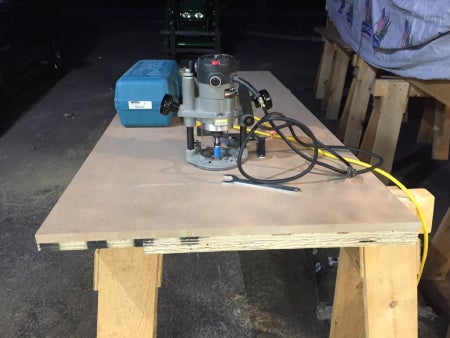
Working on the slab for the bench top. Two pieces of CDX plywood topped off with a sheet of MDF.
Make sure to account for the edging when you figure out how big your bench will be. If you work carefully, you'll want to shoot for a bench top that is about 1/4" narrower than the metal frame is wide. That should leave a nice 1/8" shadow line and give you room to get it seated. Also, the metal is not always welded all that great on these frames, as I know mine was not 100% square and many get damaged in shipping and need to be bent back into shape.
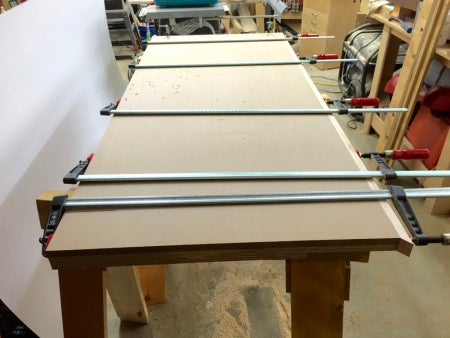
Attaching the hard maple edge banding to the slab.
Next up, I milled some hard maple stock to be the edging for the bench slab. I carefully mitered each quarter, used a biscuit joiner, and glued in biscuits to secure the edging. (By using biscuits, there are no nail holes to fill in.) Also note that the edging should only cover the top two layers of substrate—the MDF and lowest layer of plywood are what keep the bench top into the center shelf of the metal frame.
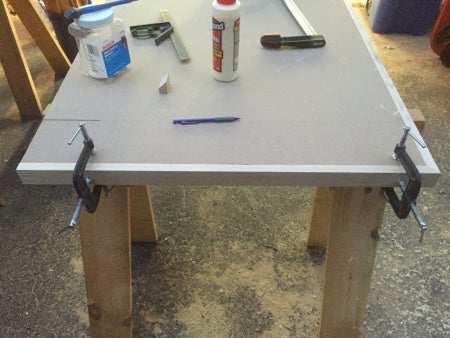
I used edge clamps to secure the edging as it dried.
When screwing together the three layers of substrate, I laid out a grid on the bottom of each layer so that my screws were spaced evenly. It also allowed me to make sure my screws would not directly overlap between layers.
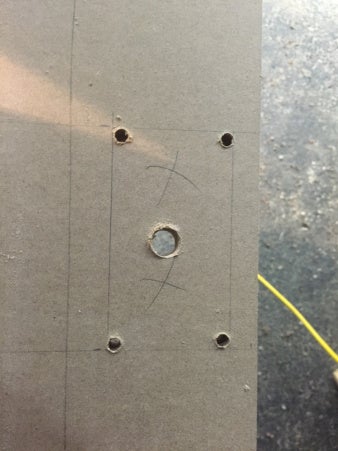
Cutting holes for outlet boxes in the rear skirt for the bench top.
When cutting the outlet holes for the backsplash, I laid them out evenly and then marked out where they would be. I drilled a small hole in each corner and a large one in the center with enough room to allow the blade of my jig saw to fit. I sawed out the space for each outlet looking to be about 1/16"-1/8" larger than the outlet box. I also used a file and rasp to clean up any rough edges.
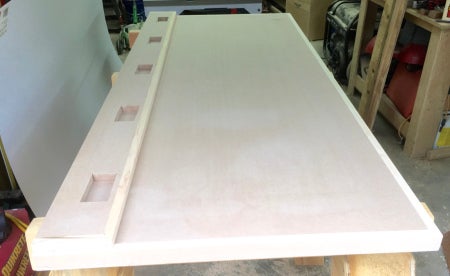
Hard maple banding around the rear skirt as well.
With the outlet holes in place, I edged the backsplash with hard maple to match the bench surface and to reinforce the MDF substrate.
I rough-cut the Formica a couple inches bigger in each direction for what it needs to cover using a saw blade with a high number of teeth (40-60 or a dedicated laminate blade would work). Then it was time to apply the contact cement.

Evenly apply the contact cement on the substrate and on the Formica.
The MDF will generally absorb more than the Formica, as it is more porous. You want to apply it liberally and evenly using a brush, roller, or spatula and bit of cardboard. You'll see where you need some more as it dries. When it dries to the point that it is evenly tacky (meaning your finger will stick to it a bit), it's time to apply the Formica.
I usually put a few dowels out on the bench substrate and then get the Formica all lined up, but not touching. Once the two tacky surfaces meet they cannot be pulled apart, so you need to get this right the first time. The dowels help you to get the alignment right before committing to it. That's also why we cut the sheet larger and trim it back once secured. Start from the center and work your way out using a J-Roller, applying as much force as you can muster. As you work your way out to the edge, you can remove more dowels until the Formica is in place. Then keep working the J-Roller until you get rid of any/all air pockets and bubbles taking longer and longer strokes working from the center out and then end to end.

Bench top with Formica and rounded edges.
To trim the Formica, I use a flush cutting router bit in a router to trim back the laminate so that it is flush with the edging. I then take a 1/8" radius round-over bit to ease all the edges with the hard maple. With the bench top complete, it was time to move on to the electrical work and assembly.

Fittings for use with armored cable
For outlets, make sure you get all of them with the right angle bracket as shown above and as shown this image. That bracket is needed to secure the outlets to the backsplash on the bench top and for the upper outlets to attach them to the metal frame.
I used Rust-Oleum Black Textured paint to paint the two outlets that will be for the light switch and its outlet because they will be visible. I also bought that can of paint to match the finish on the metal shelving/rack that is the core of this bench. Mine had lots of rub spots on it from shipping, and that would have bothered me to see every day.
I assembled the metal shelving rack as per the instructions it came with and made the height of the shelves roughly in line with what the book described. Once the rack is assembled, take a chair and sit at it to make sure the rack is at a comfortable height for your electronics work—likely a couple inches higher than what you'd want for typing at a computer. Then lift the bench top into place (you'll want help with this as it's heavy).
I attached the backsplash to the bench top using 2" wood screws. (Note I say wood screws and not drywall screws, which are flimsy in comparison. Drywall screws have much thinner shanks that can easily snap.) I then punched out the necessary holes in the outlets and screwed them into place with 5/8" long screws.
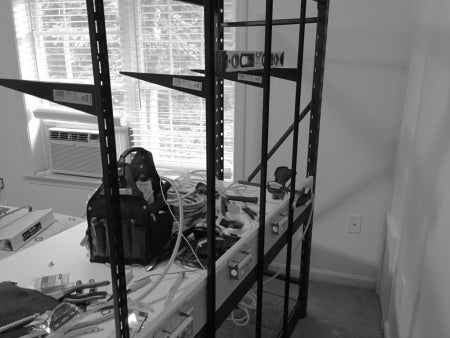
Install the shelving supports with self tapping metal screws.
I used four shelf uprights for my bench, as I felt the two called out in the book would be too flimsy. (Especially as my shelves will be covered in books and hardware and I don't want them to droop.) I measured out locations that would space the uprights equally and marked and numbered the uprights and bench with a silver marker so that if I have to move this bench, I can reassemble it with the exact same pieces in the same location.
I then took a center punch (or in a pinch, a nail set would do). Using a hammer, I hit the location I wanted to drill through the metal hard in order to make a small dent. This will help the drill bit stay where I want it as I drill through the metal. I secured the shelf supports to the top, middle, and bottom rails of the metal shelving. I also wanted to make sure they were evenly spaced between the outlets, as the armored cable will need to work around them as we'll see below.
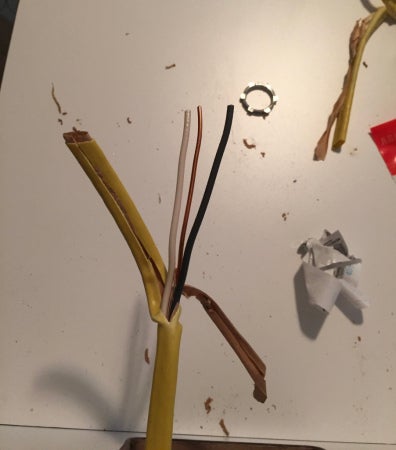
12-2 Romex cable. Remove the yellow outer jacket.
I cut the cable a solid amount longer than the distance between each box so I would have plenty of 12-gauge wire to work with. I then stripped off the yellow rolex wire jacket, as these wires will be fed through the BX metal cable armor and fittings.

Make sure to leave a generous amount of wire on each end of the armor so you have room to make your connections in the outlet box.
I cut each bit of cable armor to size and test fit it with the fittings as shown above. I then fed the wire through the armor and installed each assembly into the appropriate outlet boxes and secured the nuts that hold the fittings in the outlet boxes (see below). Note that the armored cable goes behind the shelf supports.
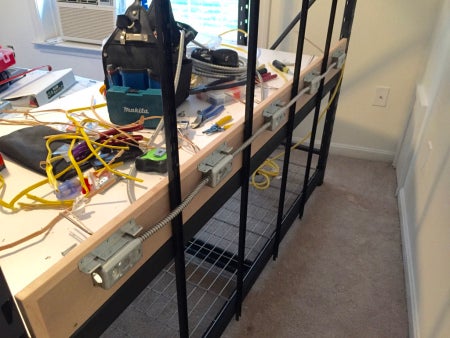
Test fitting the armored cable and related fittings
Use a heavy-duty, 12-gauge or heavier extension cord to connect your bench to the wall outlet. You'll cut off the female end and wire it into the GFCI.
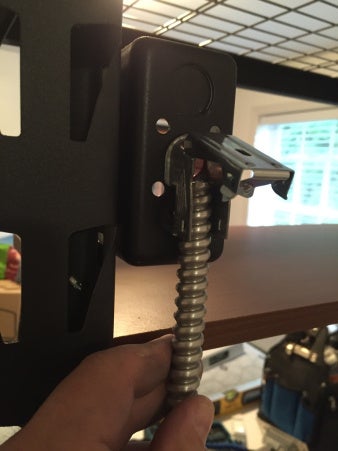
Right angle fitting for armored cable
I chose to put the outlet for the LED light and switch on the back side of the bench and run the armored cable up and around the back of the bench. I secured the cabling with a bunch of black plastic zip ties. I also needed the cabling to make a 90-degree right angle to connect the backsplash wiring to the outlet switch. The above fitting made this task easy.
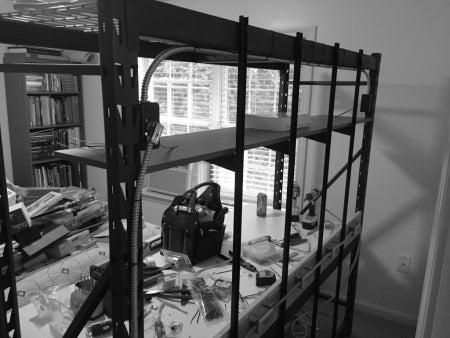
Completed rear wiring
With the cabling in place, it was time to add the shelves and start installing the receptacles.

Install the outlets
I put each switch in front of the outlet where I wanted it to make sure things were in useful positions. On the backsplash I have (from left to right): 20 Amp tamper resistant (TR) GFCI outlet, 20 Amp Decora TR outlet, 20 Amp Decora TR outlet with two USB ports in the center, 20 Amp Decora TR outlet and another 20 Amp Decora TR outlet. The top left is an outlet for the overhead utility LED light fixture. Top right is a light switch, which works out well as it's just above where the light switch on the wall is for the room lights. I also ground the metal of the bench frame to the ground of this circuit. The LED light fixture is secured with more black plastic zip ties and the cord for it is secured in the same way.
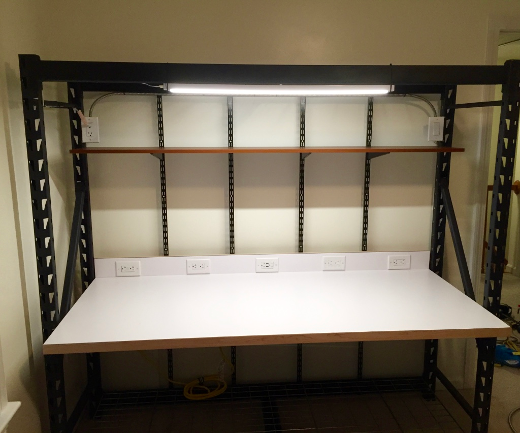
Install the switch and the LED light fixture.
I was careful in my wiring to make sure everything downstream of the GCFI was cabled correctly and checked the ground using a receptacle tester like this one. Once you test it with live power, make sure you test the GFCI and make sure all downstream outlets are cut off by the GFCI when it is tripped.

Completed bench with 3D printer and electronics tooling
With the circuits all working it was time to put on the faceplates for the outlets and start loading up the bench. I have my ESD mat that is grounded out to the wall outlet so we don't have a grounding loop. I have my Lulzbot TAZ6 on the left and my ESD mat, soldering stations and fume extractor on the right.
So far, the bench has been working out well and being able to leave a project on the bench and come back to it undisturbed has been great. Since completing it, I added two LED monitors and am working on a CNC-controlled gaming keyboard tray.
If you build your own version of this workbench, I'd love to hear about it in the comments below.
Original post an author's blog, TinWhiskerz.

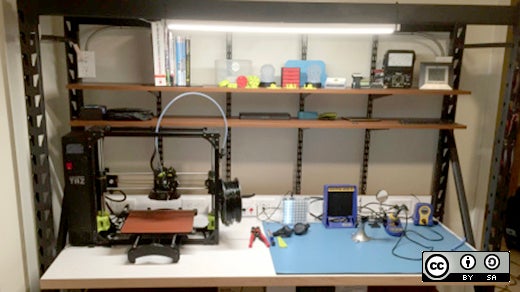


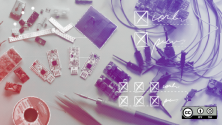


4 Comments